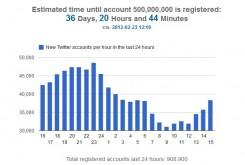 Sometimes it feels as if nobody leaves the house without a smartphone and tablet in tow. “Here, let me show you something,” a friend will say, whipping out one screen or another to display the latest video or app. Those tablets and smartphones are one the main reasons why the number of Internet-connected, app-enabled devices in U.S. homes just hit half a billion, according to new estimates from research firm The NPD Group. Individual households contain an average of 5.7 connected devices. The NPD Group’s survey involved 4,000 U.S. consumers aged 18 and older, surveyed in the first quarter of this year. The firm then used that information to extrapolate its broader estimates. Just because tablets and smartphones are ascendant, however, doesn’t mean that people are tossing out their desktops and laptops. “Even with this extraordinary growth in the smartphone and tablet market, PCs are still the most prevalent connected device in U.S. Internet households, and this is a fact that won’t be changing any time soon,” John Buffone, director of devices for NPD’s Connected Intelligence, wrote in a March 18 statement. However, he added, “when you look at the combined number of smartphones and tablets consumers own, for the first time ever it exceeded the installed base of computers.” The table above demonstrates the extent of that growth, with tablets and smartphones enjoying significant quarter-over-quarter gains in household penetration even as PCs, despite their enviable market-share, barely gain share. That dichotomy may grow more lopsided in the years ahead. “It’s hard to believe that tablets and smartphones are still somewhat in their infancy,” Buffone wrote. “But as we have seen in just the past few months, there is significant potential for this market to develop further.” Earlier this year, The NPD Group estimated that Internet-connected devices now outnumber U.S. residents, with 1.3 pieces of Web-enabled hardware for every man, woman and child in the country. But that study included Blu-ray disc players, HDTVs, and other devices that weren’t necessarily app-enabled—a crucial distinction. Image: Africa Studio/Shutterstock.com
Sometimes it feels as if nobody leaves the house without a smartphone and tablet in tow. “Here, let me show you something,” a friend will say, whipping out one screen or another to display the latest video or app. Those tablets and smartphones are one the main reasons why the number of Internet-connected, app-enabled devices in U.S. homes just hit half a billion, according to new estimates from research firm The NPD Group. Individual households contain an average of 5.7 connected devices. The NPD Group’s survey involved 4,000 U.S. consumers aged 18 and older, surveyed in the first quarter of this year. The firm then used that information to extrapolate its broader estimates. Just because tablets and smartphones are ascendant, however, doesn’t mean that people are tossing out their desktops and laptops. “Even with this extraordinary growth in the smartphone and tablet market, PCs are still the most prevalent connected device in U.S. Internet households, and this is a fact that won’t be changing any time soon,” John Buffone, director of devices for NPD’s Connected Intelligence, wrote in a March 18 statement. However, he added, “when you look at the combined number of smartphones and tablets consumers own, for the first time ever it exceeded the installed base of computers.” The table above demonstrates the extent of that growth, with tablets and smartphones enjoying significant quarter-over-quarter gains in household penetration even as PCs, despite their enviable market-share, barely gain share. That dichotomy may grow more lopsided in the years ahead. “It’s hard to believe that tablets and smartphones are still somewhat in their infancy,” Buffone wrote. “But as we have seen in just the past few months, there is significant potential for this market to develop further.” Earlier this year, The NPD Group estimated that Internet-connected devices now outnumber U.S. residents, with 1.3 pieces of Web-enabled hardware for every man, woman and child in the country. But that study included Blu-ray disc players, HDTVs, and other devices that weren’t necessarily app-enabled—a crucial distinction. Image: Africa Studio/Shutterstock.com Web-Connected Devices Top 500 Million in the U.S.
 Sometimes it feels as if nobody leaves the house without a smartphone and tablet in tow. “Here, let me show you something,” a friend will say, whipping out one screen or another to display the latest video or app. Those tablets and smartphones are one the main reasons why the number of Internet-connected, app-enabled devices in U.S. homes just hit half a billion, according to new estimates from research firm The NPD Group. Individual households contain an average of 5.7 connected devices. The NPD Group’s survey involved 4,000 U.S. consumers aged 18 and older, surveyed in the first quarter of this year. The firm then used that information to extrapolate its broader estimates. Just because tablets and smartphones are ascendant, however, doesn’t mean that people are tossing out their desktops and laptops. “Even with this extraordinary growth in the smartphone and tablet market, PCs are still the most prevalent connected device in U.S. Internet households, and this is a fact that won’t be changing any time soon,” John Buffone, director of devices for NPD’s Connected Intelligence, wrote in a March 18 statement. However, he added, “when you look at the combined number of smartphones and tablets consumers own, for the first time ever it exceeded the installed base of computers.” The table above demonstrates the extent of that growth, with tablets and smartphones enjoying significant quarter-over-quarter gains in household penetration even as PCs, despite their enviable market-share, barely gain share. That dichotomy may grow more lopsided in the years ahead. “It’s hard to believe that tablets and smartphones are still somewhat in their infancy,” Buffone wrote. “But as we have seen in just the past few months, there is significant potential for this market to develop further.” Earlier this year, The NPD Group estimated that Internet-connected devices now outnumber U.S. residents, with 1.3 pieces of Web-enabled hardware for every man, woman and child in the country. But that study included Blu-ray disc players, HDTVs, and other devices that weren’t necessarily app-enabled—a crucial distinction. Image: Africa Studio/Shutterstock.com
Sometimes it feels as if nobody leaves the house without a smartphone and tablet in tow. “Here, let me show you something,” a friend will say, whipping out one screen or another to display the latest video or app. Those tablets and smartphones are one the main reasons why the number of Internet-connected, app-enabled devices in U.S. homes just hit half a billion, according to new estimates from research firm The NPD Group. Individual households contain an average of 5.7 connected devices. The NPD Group’s survey involved 4,000 U.S. consumers aged 18 and older, surveyed in the first quarter of this year. The firm then used that information to extrapolate its broader estimates. Just because tablets and smartphones are ascendant, however, doesn’t mean that people are tossing out their desktops and laptops. “Even with this extraordinary growth in the smartphone and tablet market, PCs are still the most prevalent connected device in U.S. Internet households, and this is a fact that won’t be changing any time soon,” John Buffone, director of devices for NPD’s Connected Intelligence, wrote in a March 18 statement. However, he added, “when you look at the combined number of smartphones and tablets consumers own, for the first time ever it exceeded the installed base of computers.” The table above demonstrates the extent of that growth, with tablets and smartphones enjoying significant quarter-over-quarter gains in household penetration even as PCs, despite their enviable market-share, barely gain share. That dichotomy may grow more lopsided in the years ahead. “It’s hard to believe that tablets and smartphones are still somewhat in their infancy,” Buffone wrote. “But as we have seen in just the past few months, there is significant potential for this market to develop further.” Earlier this year, The NPD Group estimated that Internet-connected devices now outnumber U.S. residents, with 1.3 pieces of Web-enabled hardware for every man, woman and child in the country. But that study included Blu-ray disc players, HDTVs, and other devices that weren’t necessarily app-enabled—a crucial distinction. Image: Africa Studio/Shutterstock.com 
